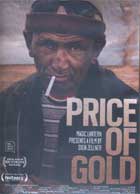
Price of Gold 2011
Distributed by Magic Lantern Films, PO Box 8567, New York, NY 10116; 646-926-6760
Produced by Maximilian Plettau
Directed by Sven Zeller, Chingunjav Borkhuu
DVD, color, 86 min.
Jr. High - General Adult
Southeast Asia, Human Rights, Labor, Ecology, Culture
Date Entered: 01/02/2014
Reviewed by Monique Threatt, Indiana University, Herman B Wells Library, Bloomington, IN
“Foreign companies have long divided up the mining rights for gold, at the detriment of the indigenous people. 10 years ago some nomads started prospecting for gold. Nowadays 100,000 people are digging illegally for gold in Mongolia.” – IntroMongolia is a country rich in copper and gold. It is also a country being exploited for its resources by international businesses. What should have left a poor country in better economic conditions has done little to improve the plight of the Mongolian people. Sven Zeller’s feature-length documentary focuses on a group of nomadic Mongolians illegally prospecting for gold. Using man-made dynamite, make-shift baskets to bring the rocks to the surface for sifting, antiquated machinery, and creating their own mercury to separate the gold from the rocks, these prospectors are optimistic that they will find enough gold to improve their economic and social condition. As noted by one of the bosses, “the Mongolian people respect Mother Earth, and do not wish to exploit her. But, the people are poor. Life is hard. Gold digging is a fight for survival.”
This documentary takes place over 273 days in various locations in the Gobi Desert. It documents one crew’s search for gold to include two bosses, three workers and one woman who serves as a house mother. Although very knowledgeable in the trade, the bosses are at times bullies, and exert power in order to keep the men on schedule and to deter theft. If a worker is caught stealing rocks, punishment can range from work without pay, to death. Since this is an illegal activity, the bosses must also bribe the police, and keep away local villagers who run the risk of reporting the crew to environmental agencies. When the men are not performing back-breaking work, they drive into town for supplies and to sell their goods. They also engage in drinking, lewd language and behavior, and games to pass the time.
For all its labor-intensive work, most of the men agree that this is a job that is suitable for them. They love their country and its mountains and deserts. They would prefer to be in the open air than working a normal job. Still, the film is another example of cheap laborers picking at scraps left behind by big businesses who have raped and reaped the rewards. The cinematography is breathtaking, and traditional folksongs add to the lore of the history of the land and the people. Includes the graphic image of killing an animal for food, and the selling of animals for money. In Mongolian with English subtitles. I recommend this film for public, school and academic libraries.